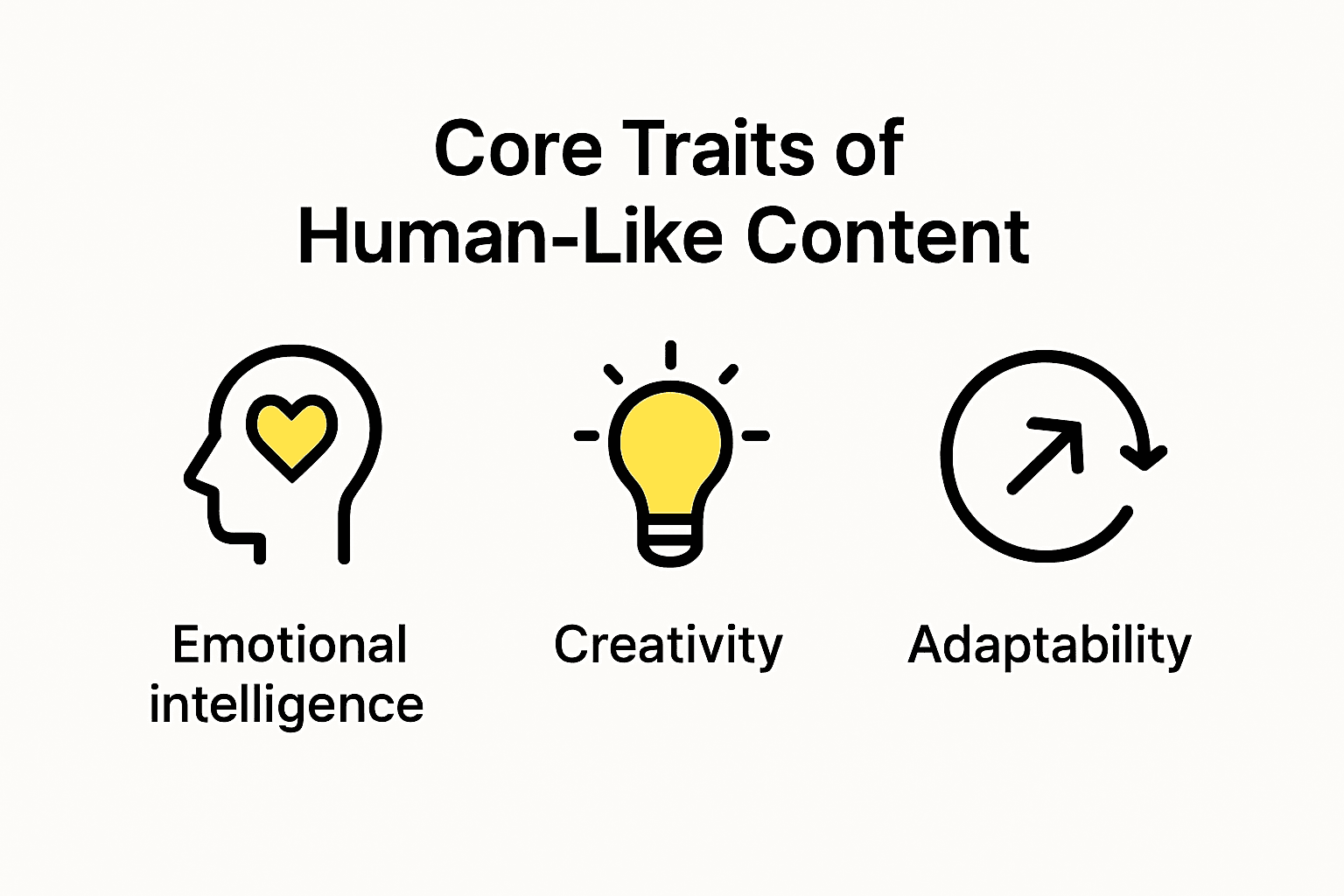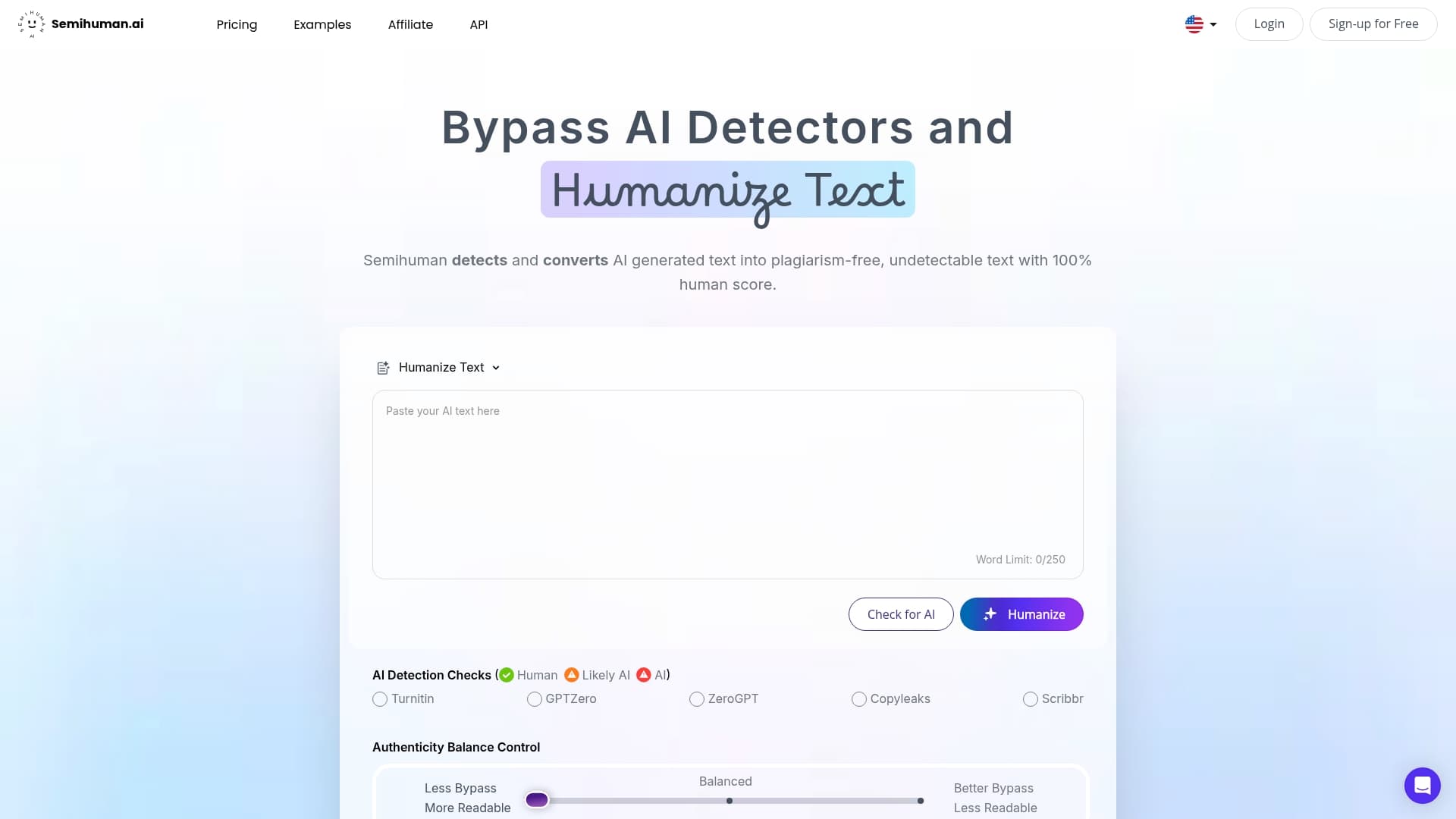Blog
Learning Materials
Wat maakt inhoud menselijk? Belangrijke elementen voor 2025
Updated: June 18, 2025

Iedereen praat over AI-content, maar er is iets verrassends dat opvalt. Uit onderzoeken blijkt dat door mensen gegenereerde content door meer dan 6.200 deelnemers als aanzienlijk empathischer en ondersteunender wordt beoordeeld in vergelijking met door AI geschreven tekst. Je zou denken dat technologie het gat heeft gedicht, maar het geheime ingrediënt ontbreekt nog steeds. Echte verbinding, emotionele intelligentie en persoonlijkheid zijn wat mensachtige schrijfstijl zelfs in 2025 onderscheidt.
Inhoudsopgave
- Emotionele Intelligentie en Contextueel Begrip
- Creativiteit en Contextuele Aanpassingsvermogen
- Linguïstische Nuance en Authentieke Stem
- De Emotionele Architectuur van Stem
- Personalisatie als Stemstrategie
- Professionele Stem en Authenticiteitssignalen
- Verhalen Vertellen en Persoonlijk Perspectief
- Conversatietaal en Emotionele Weerklank
- Empathie en Lezergerichte Communicatie
- Vertrouwen en Geloofwaardigheid door Authentieke Ervaring
- Emotionele Intelligentie en Contextuele Nuance
- Strategisch Verhalen Vertellen en Publieksverbinding
Korte Samenvatting
| Conclusie | Uitleg |
|---|---|
| Emotionele Intelligentie is Essentieel | Mensachtige content moet het vermogen tonen om empathie te hebben met de ervaringen van het publiek en zich aan te passen aan verschillende contexten, waardoor emotionele verbindingen essentieel zijn voor betrokkenheid. |
| Creativiteit Houdt Content Boeiend | Content moet onverwachte wendingen en gepersonaliseerde verhalen bevatten die spontaan en boeiend aanvoelen om de interesse van de lezer te behouden. |
| Authenticiteit door Toon en Stem | De wisselwerking tussen toon en stem transformeert content van louter informatie naar boeiende verhalen, waardoor authenticiteit cruciaal is voor het opbouwen van vertrouwen en verbinding met lezers. |
| Personalisatie Versterkt Verbinding | Het afstemmen van content op specifieke doelgroepen met behulp van contextuele taal en responsieve communicatiestijlen leidt tot hogere betrokkenheid en een meer herkenbare ervaring. |
| Strategisch Verhalen Vertellen is de Sleutel | Focussen op strategisch verhalen vertellen dat emotioneel resoneert met doelgroepen is effectiever dan de pure hoeveelheid content, waardoor diepere verbindingen en blijvende impact mogelijk zijn. |
Kernkenmerken van Mensachtige Content
Het creëren van content die echt resoneert met menselijke lezers vereist meer dan alleen het samenvoegen van woorden. Wat content mensachtig maakt, gaat verder dan louter grammaticale correctheid of informatieoverdracht. Het gaat om het vastleggen van de essentie van menselijke communicatie—nuance, emotioneel en inherent adaptief.

Emotionele Intelligentie en Contextueel Begrip
Mensachtige content toont een diepgaand vermogen om emotioneel te verbinden en context te begrijpen. Volgens onderzoek van de Society for Human Resource Management weerspiegelt echt authentieke content emotionele intelligentie door verschillende belangrijke kenmerken. Dit betekent verder gaan dan oppervlakkige informatie om verhalen te creëren die echte gevoelens en ervaringen oproepen.
Lezers herkennen mensachtige content aan het vermogen om:
- Empathie te tonen met de ervaringen van het publiek
- Subtiele emotionele ondertonen te herkennen
- Communicatiestijl aan te passen aan verschillende contexten
Een technische uitleg geschreven met mensachtige kwaliteiten zou bijvoorbeeld niet alleen feiten presenteren, maar ook anticiperen op vragen van de lezer, mogelijke zorgen aanpakken en herkenbare voorbeelden geven die complexe informatie verteerbaar maken.
Creativiteit en Contextuele Aanpassingsvermogen
Puur informatieoverdracht mist de vonk die menselijke communicatie boeiend maakt. Technologieonderzoek van TechXplore benadrukt dat mensachtige content creativiteit en realtime aanpassingsvermogen moet tonen. Dit betekent het ontwikkelen van content die spontaan aanvoelt, enigszins onvoorspelbaar is en de lezer kan verrassen.
Creativiteit in content manifesteert zich door:
- Onverwachte wendingen in het verhaal
- Gepersonaliseerde vertelbenaderingen
- Contextuele verwijzingen die organisch aanvoelen
Een mensachtig stuk schrijven informeert niet alleen—het boeit, vermaakt en laat lezers voelen alsof ze deel uitmaken van een gesprek in plaats van een monoloog te ontvangen. De content anticipeert op de nieuwsgierigheid van de lezer, reageert op impliciete vragen en behoudt een conversatieritme dat natuurlijk en ongeforceerd aanvoelt.
Linguïstische Nuance en Authentieke Stem

Linguïstische complexiteit scheidt robotachtige tekst van mensachtige content. Dit gaat verder dan grammatica—het gaat om het begrijpen van toon, subtekst en de subtiele kunst van communicatie. Authentieke content weerspiegelt een individueel perspectief, bevat strategische imperfecties en toont een unieke stem die persoonlijk en oprecht aanvoelt.
Belangrijke linguïstische kenmerken zijn onder andere:
- Natuurlijke variatie in zinnen
- Contextueel gepaste humor
- Persoonlijke anekdotes en verwijzingen
Wanneer lezers content tegenkomen die aanvoelt alsof het is gemaakt door een echt persoon met oprechte ervaringen en perspectieven, zijn ze meer geneigd om verbinding te maken, te vertrouwen en zich bezig te houden met het materiaal. Het doel is niet perfectie, maar authenticiteit—een kwaliteit die AI moeite heeft om consequent te repliceren.
Begrijpen wat content mensachtig maakt, vereist het erkennen dat communicatie een kunstvorm is, niet alleen een technisch proces van informatieoverdracht. Het gaat om het creëren van een verbinding die woorden overstijgt, direct spreekt tot de ervaringen, emoties en intellectuele nieuwsgierigheid van de lezer.
Hoe Toon en Stem Authenticiteit Vormen
Authenticiteit in content ontstaat door een verfijnde wisselwerking van toon en stem—een genuanceerde communicatiestrategie die woorden transformeert van louter informatie naar boeiende verhalen. Wat content mensachtig maakt, gaat veel verder dan grammaticale precisie naar het rijk van emotionele resonantie en individueel karakter.
De Emotionele Architectuur van Stem
Onderzoek van Flowster onthult een cruciaal inzicht: content die als menselijk gegenereerd wordt waargenomen, presteert consequent beter dan door AI geproduceerde tekst in emotionele verbinding. In een uitgebreide studie met 6.282 deelnemers werd door mensen gemaakte content als aanzienlijk empathischer en ondersteunender beoordeeld, wat meer positieve emotionele reacties genereerde.
Emotionele authenticiteit manifesteert zich door verschillende belangrijke dimensies:
- Kwetsbaarheid die oprechte menselijke ervaring onthult
- Contextuele gevoeligheid voor de stemming en verwachtingen van het publiek
- Spontane variaties in het verhaal
Deze emotionele architectuur betekent verder gaan dan klinische informatieoverdracht naar het creëren van content die aanvoelt als een gesprek met een vertrouwde vriend. De toon wordt een brug die ruwe informatie verbindt met betekenisvolle menselijke ervaring.
Personalisatie als Stemstrategie
Marktonderzoek van Just Agency geeft aan dat personalisatie de grens vertegenwoordigt van authentieke communicatie. Merken die hun stem aanpassen aan specifieke doelgroepen zien dramatisch hogere betrokkenheidspercentages. Dit gaat niet over generieke segmentatie, maar over het creëren van content die individueel gemaakt aanvoelt.
Personalisatiestrategieën omvatten:
- Aanpassing van contextuele taal
- Doelgroep-specifieke vertelbenaderingen
- Responsieve communicatiestijlen
Een technisch document voor ingenieurs zal merkbaar anders klinken dan content die zich richt op creatieve professionals. De onderliggende informatie kan identiek zijn, maar de stem transformeert de ervaring van het consumeren van die informatie.
Professionele Stem en Authenticiteitssignalen
Industrie-inzichten van Outspoken Voices benadrukken dat 80% van de professionals prioriteit geeft aan mensachtige kwaliteiten in communicatie. Dit strekt zich uit voorbij geschreven content naar bredere communicatiestrategieën waar stem een cruciaal authenticiteitssignaal wordt.
Authentieke stemkenmerken omvatten:
- Natuurlijke conversatieritmes
- Strategische imperfecties die oprecht aanvoelen
- Contextueel gepaste emotionele reikwijdte
Het doel is niet perfectie, maar geloofwaardigheid. Lezers kunnen intuïtief aanvoelen wanneer content aanvoelt als gefabriceerd versus wanneer het oprecht gemaakt aanvoelt. Een authentieke stem onthult de mens achter de woorden—compleet met perspectieven, mogelijke vooroordelen en unieke vertelbenaderingen.
Uiteindelijk vertegenwoordigen toon en stem het digitale equivalent van lichaamstaal. Ze communiceren veel meer dan letterlijke betekenis, onthullen persoonlijkheid, expertise en emotionele intelligentie. In een wereld die steeds meer verzadigd is met door AI gegenereerde content, wordt de menselijke touch niet alleen een voorkeur, maar een concurrentievoordeel.
Praktische Technieken om je Schrijfwerk te Humaniseren
Het transformeren van schrijven van mechanische tekst naar authentieke communicatie vereist bewuste strategieën die woorden tot leven brengen. Het humaniseren van content is een kunstvorm die verder gaat dan grammatica en structuur—het gaat om het creëren van oprechte verbindingen met lezers door middel van doordachte, herkenbare communicatie.
Verhalen Vertellen en Persoonlijk Perspectief
Onderzoek van Search Engine Journal onthult dat schrijvers die effectief in de schoenen van de lezer stappen, meer boeiende en betrouwbare content creëren. Verhalen vertellen wordt een krachtig hulpmiddel voor het humaniseren van schrijven, waardoor abstracte concepten worden getransformeerd in tastbare ervaringen.
Effectieve verteltechnieken omvatten:
- Persoonlijke anekdotes die belangrijke punten illustreren
- Voorbeelden uit de echte wereld die informatie contextualiseren
- Kwetsbare momenten die authenticiteit tonen
In plaats van droge statistische gegevens over productiviteit te presenteren, deel bijvoorbeeld een persoonlijke worsteling met tijdmanagement en hoe je deze hebt overwonnen. Deze benadering transformeert informatie in een verhaal waarmee lezers zich emotioneel kunnen verbinden. Als je dieper wilt duiken in het verbeteren van je schrijfvaardigheden, bekijk dan onze gids over het verbeteren van schrijfvaardigheden.
Conversatietaal en Emotionele Weerklank
Authentiek schrijven bootst natuurlijke conversatie na. Dit betekent verder gaan dan formele taal om tekst te creëren die aanvoelt als een dialoog met een vertrouwde vriend. Gebruik taal die weerspiegelt hoe mensen daadwerkelijk spreken—met ritme, imperfectie en oprechte emotie.
Belangrijke conversatieschrijftechnieken:
- Stel retorische vragen
- Gebruik samentrekkingen en informele taal
- Incorporeer humor en persoonlijkheid
Overweeg hoe je een complex onderwerp aan een vriend zou uitleggen tijdens een kop koffie. Die conversatiebenadering breekt barrières tussen schrijver en lezer, waardoor complexe informatie toegankelijker en boeiender wordt.
Empathie en Lezergerichte Communicatie
Echte humanisatie vereist diepe empathie. Dit betekent het begrijpen van de uitdagingen, angsten, hoop en motivaties van je publiek. Je schrijven moet aanvoelen als een ondersteunend gesprek, niet als een afstandelijke monoloog.
Empathie-gedreven schrijftechnieken:
- Spreek de zorgen van de lezer direct aan
- Gebruik inclusieve taal
- Toon begrip van de ervaringen van de lezer
Wanneer lezers zich gezien en begrepen voelen, zijn ze meer geneigd om je content te vertrouwen. Dit gaat verder dan oppervlakkige erkenning—het gaat om het tonen van oprecht begrip van hun unieke uitdagingen en perspectieven.
Het humaniseren van schrijven gaat uiteindelijk over het afbreken van barrières. Het is een delicate balans van professioneel inzicht en persoonlijke verbinding. De meest memorabele content informeert niet alleen—het laat lezers zich begrepen, ondersteund en geïnspireerd voelen. Door te focussen op authentieke communicatie, transformeer je schrijven van een mechanisch proces naar een betekenisvolle menselijke interactie.
Waarom de Menselijke Touch Cruciaal is voor Content Succes
In een tijdperk dat wordt gedomineerd door kunstmatige intelligentie en algoritmische contentgeneratie, blijft de menselijke touch de kritische onderscheidende factor tussen vergeetbare tekst en echt transformerende communicatie. Succes in contentcreatie gaat niet langer over volume of technische precisie, maar over oprechte verbinding en betekenisvolle betrokkenheid.
Vertrouwen en Geloofwaardigheid door Authentieke Ervaring
Onderzoek van NewsWire Jet benadrukt dat gebruikersvertrouwen steeds meer afhangt van content die wordt ondersteund door directe menselijke ervaring. In 2025 worden doelgroepen steeds kritischer en zoeken ze naar verhalen die echte wereldinzichten weerspiegelen in plaats van generieke, door machines gegenereerde informatie.
Belangrijke elementen van vertrouwen opbouwen zijn onder andere:
- Persoonlijke verhalen met verifieerbare expertise
- Transparante erkenning van beperkingen
- Demonstratie van een oprechte professionele reis
Wanneer content echte menselijke begrip weerspiegelt, overstijgt het louter informatieoverdracht. Lezers kunnen het verschil voelen tussen algoritmisch samengestelde tekst en verhalen die zijn gemaakt vanuit geleefde ervaring. Als je je vertelvaardigheden wilt verbeteren, verken dan onze gids voor authentieke contentcreatie.
Emotionele Intelligentie en Contextuele Nuance
Inzichten van Think Like a Publisher benadrukken dat complexe onderwerpen meer vereisen dan feitelijke nauwkeurigheid—ze vereisen emotionele intelligentie en contextueel begrip dat alleen menselijke makers kunnen bieden. Vooral in gevoelige domeinen zoals gezondheidszorg, ethiek of persoonlijke ontwikkeling, wordt de menselijke touch onmisbaar.
Emotionele intelligentie in content manifesteert zich door:
- Empathische interpretatie van complexe scenarios
- Genuanceerde omgang met controversiële onderwerpen
- Contextuele aanpassing van communicatiestijl
Een machine kan informatie samenstellen, maar kan de subtiele emotionele landschappen die menselijke besluitvorming en begrip informeren niet echt begrijpen.
Strategisch Verhalen Vertellen en Publieksverbinding
DigitalOft onderzoek onthult dat content succes in 2025 zal draaien om strategisch verhalen vertellen—niet om meer content te produceren, maar om de juiste content te creëren die emotioneel en betekenisvol resoneert met doelgroepen.
Kenmerken van strategisch verhalen vertellen zijn onder andere:
- Verhalen die de aspiraties van het publiek weerspiegelen
- Persoonlijke kwetsbaarheid en authenticiteit
- Contextueel relevante emotionele betrokkenheid
De meest boeiende content doet meer dan informeren—het transformeert. Het spreekt direct tot individuele ervaringen, uitdagingen en dromen. Terwijl AI tekst kan genereren, kunnen alleen mensen verhalen creëren die echt bewegen, inspireren en een blijvende impact hebben.
Uiteindelijk gaat de menselijke touch over het erkennen dat communicatie geen transactie is, maar een diepgaande daad van verbinding. In een wereld die steeds meer wordt bemiddeld door technologie, zal de meest waardevolle content altijd die zijn die ons herinnert aan onze gedeelde menselijkheid—complex, imperfect en prachtig genuanceerd.
Veelgestelde Vragen
Wat zijn de belangrijkste elementen die content mensachtig doen aanvoelen?
Mensachtige content wordt gekenmerkt door emotionele intelligentie, creativiteit, linguïstische nuance en authentieke stem. Het maakt emotionele verbindingen met lezers en past zich aan verschillende contexten aan.
Hoe beïnvloedt emotionele intelligentie contentcreatie?
Emotionele intelligentie in contentcreatie houdt in dat je de ervaringen van het publiek begrijpt en empathie toont. Dit helpt schrijvers om verhalen te creëren die diep resoneren met lezers, waardoor betrokkenheid en vertrouwen worden vergroot.
Waarom is authenticiteit belangrijk in schrijven?
Authenticiteit is cruciaal omdat het vertrouwen en geloofwaardigheid bij lezers opbouwt. Content die persoonlijke verhalen, emotionele resonantie en een unieke stem bevat, voelt herkenbaarder en boeiender aan, waardoor het effectiever is.
Welke technieken kan ik gebruiken om mijn schrijfwerk te humaniseren?
Om je schrijfwerk te humaniseren, kun je verhalen vertellen, conversatietaal gebruiken en empathie tonen. Door persoonlijke anekdotes te delen en lezers op emotioneel niveau te betrekken, zal je content authentieker en herkenbaarder aanvoelen.
Klaar om je AI-tekst om te zetten in echt Mensachtige Content?
Je hebt gezien hoe mensachtige kwaliteiten—authentieke stem, emotionele intelligentie, genuanceerd verhalen vertellen—content onderscheiden in 2025. Maar het creëren van dit niveau van authenticiteit kan moeilijk zijn wanneer je op AI vertrouwt of detectiecontroles moet doorstaan. Heb je moeite met het feit dat je content vlak aanvoelt, wordt gemarkeerd door Turnitin, GPTZero of Copyleaks, of gewoon niet resoneert met je publiek?

Nu is het perfecte moment om de kloof te overbruggen. Semihuman.ai helpt je om generieke AI-tekst om te zetten in natuurlijke, lezergerichte content die echt verbindt.
- Herstructureer zinnen naadloos zodat ze authentiek lezen
- Bouw emotionele resonantie op die machines missen
- Omzeil AI-detectoren en verbeter tegelijkertijd je SEO
Stop met het laten markeren of negeren van je harde werk. Ontdek hoe je menselijker kunt klinken, vertrouwen kunt vergroten en sneller ontdekt kunt worden door vandaag nog Semihuman.ai te bezoeken, of bekijk onze tips voor het verbeteren van schrijfvaardigheden om te beginnen met het creëren van content die je publiek zal onthouden.
Aanbevolen Artikelen
- Hoe AI-tekst te Humaniseren? (AI Humanizer & 9 Andere Bewezen Manieren)
- 9 Beste Ondetecteerbare AI-tools om AI-tekst te Humaniseren
- Maak AI-content Ondetecteerbaar met 5 Bewezen Methoden
- Holistische Haarverzorging in 2025: Sterker, Gezond Haar Groeien | MyHair
Generate essays with Samwell.ai
Whether you’re a publisher, professor, journalist, or student, let us tailor a plan just for you.Meest gelezen artikelen

Gids voor het succesvol schrijven van opdrachten
Professionele tips voor het schrijven van essays: van het formuleren van argumenten tot het effectief opbouwen van de structuur van je essay.

Schrijfvaardigheden: Beheersing van schrijfstrategieën
Verrijk het schrijven van je essay met advies van experts, inclusief analyse, het formuleren van een these en effectieve structurering.

Hoe schrijf je een kritisch reflectief essay: Tips van experts
Experttips: Hoe schrijf je een kritisch reflectief essay. Leer hoe je het structureert, een onderwerp kiest en bewijsmateriaal effectief gebruikt.

Hoe schrijf je een effectieve inleiding: een stap-voor-stap gids
Beheers de kunst van het creëren van boeiende introducties met onze gids. Maak interessante starts die een onuitwisbare indruk achterlaten.
